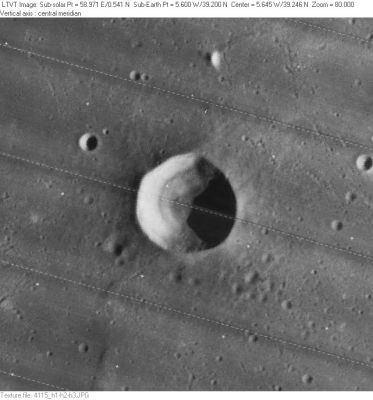Kirch
Contents
- 1 Kirch
- 2 Table of Contents
- 2.1 Images
- 2.2 Maps
- 2.3 Description
- 2.4 Description: Elger
- 2.5 Description: Wikipedia
- 2.6 Additional Information
- 2.7 Are there possible variations of brightness at the small (officially unnamed) hill immediately north of Kirch?
- 2.8 The LRO's close up of the small hill north of Kirch
- 2.9 Nomenclature
- 2.10 LPOD Articles
- 2.11 Bibliography
- 2.12 Gottfried (or Christian?) Kirch in the Sourcebook Project (William R. Corliss)
Kirch
|
Lat: 39.2°N, Long: 5.6°W, Diam: 11 km, Depth: 1.83 km, Rükl: 12 |
Table of Contents
 LO-IV-115H
LO-IV-115HNote the curious "pinnacle" just north of Kirch. This hillock was once a little mystery for the dedicated lunar observer Harold Hill (see his superb book A PORTFOLIO OF LUNAR DRAWINGS) (the Kirch case is described at the lower part of this page, below the Additional Information section).
Images
LPOD Photo Gallery Lunar Orbiter Images
Although Kirch is not mentioned in the LPI's database for orbital Apollo photographs, this crater WAS photographed by the Fairchild mapping-metric camera of Apollo 15! One of those oblique north looking Fairchild frames is AS15-M-1544. In this frame, Kirch is visible a little bit below the most upper (and central) part of the curved horizon.
Research: Danny Caes
Maps
(LAC zone 25D2) LAC map Geologic map
Description
Description: Elger
(IAU Directions) KIRCH.--A rather smaller object of the same class on the S.W.
Description: Wikipedia
Additional Information
- Depth data from Kurt Fisher database
Arthur, 1974: 1.83 km
Westfall, 2000: 1.83 km
Viscardy, 1985: 1.83 km - From the shadows in LO-IV-115H, Kirch is 1870-1900 m deep. - JimMosher JimMosher
- Kirch is at least 1700 m deep. Its western wall rises 1400 m above the surrounding mare--Boint selenologysummer07a. - fatastronomer fatastronomer
- TSI = 20, CPI = 5, FI = 10; MI =35 Smith and Sanchez, 1973
Are there possible variations of brightness at the small (officially unnamed) hill immediately north of Kirch?
Page 60 of the book A Portfolio of Lunar Drawings (Harold Hill, 1991) has an interesting description of an observation performed on October the 29th, 1983 (with sketches of the Spitzbergen mountains). During that night, the small unnamed hill immediately north of crater Kirch looked abnormally bright.
Harold Hill:
- I have observed this object on several occasions since under both morning and evening illumination but, though very bright, it has never reached the intensity recorded on October the 29th, 1983. It should be kept under close surveillance for possible variations.
The LRO's close up of the small hill north of Kirch
Danny Caes, June the 23th, 2012:
- Examination of Hi-Res photographs of the small hill north of Kirch, made by the Lunar Reconnaissance Orbiter (LRO), reveal a boulder track on its northern slope and (what seems to be) a striated pattern, very much like the parallel "grooves" on the southwestern slope of Mount Hadley (as they show up on photographs made during the mission of Apollo 15 in the summer of 1971).
Nomenclature
- Named for Gottfried Kirch (December 18, 1639 - July 25, 1710), a German astronomer. He began to learn astronomy in Jena, and studied under Hevelius in Danzig. In Danzig in 1667, Kirch published calendars and built several telescopes and instruments. In 1686, Kirch went to Leipzig. There, he observed the great comet of 1686, together with Christoph Arnold. At Leipzig, Kirch also met his second wife, Maria Margarethe Winckelmann (1670-1720), who had learned astronomy from Arnold. In 1688, he invented and charted the now obsolete constellation Sceptrum Brandenburgicum, the Brandenburg Scepter. Kirch studied the double star Mizar, and discovered both the Wild Duck Cluster (Messier 11) (1681) and Globular Cluster M5 (May 5, 1702). He also discovered the variability of the Mira variable Chi Cygni in 1686.
- According to Whitaker (p. 218), this name was introduced by Schröter, but it was used to designate a peak. Whitaker does not explain which peak that may have been, but from Schröter's drawing it's clear it was Montes Spitzbergen.
- Kirch pinnacle (a nickname from D.Caes for the officially unnamed hillock immediately north of Kirch) (that hillock is not even mentioned on chart SLC D2 of the System of Lunar Craters, 1966). In reality, this so-called pinnacle doesn't show steep slopes. It's just an optical illusion caused by the hillock's high albedo versus its "black" shadow.
LPOD Articles
Peaks, Swells and Ridges
Everything is Here (telescopic High Resolution photograph of Kirch and the small unnamed hillock north of it, by Christian Viladrich).
Bibliography
Harold Hill. A Portfolio of Lunar Drawings, pages 60, 61 (sketch d.).
Gottfried (or Christian?) Kirch in the Sourcebook Project (William R. Corliss)
- Page 96 in: Mysterious Universe, a handbook of astronomical anomalies (1979) :
- On the Visibility of the Dark Side of Venus (A. Schafarik, Report of the British Association, 1873).
Now, here we have a real enigma, because there seems to be no online information about a certain Christian Kirch (although this astronomer is mentioned on page 96 of Mysterious Universe). Was the name Christian perhaps an error, and should it have been Gottfried instead? Gottfried Kirch was alive from 1639 to 1710, while Christian Kirch observed the illuminated nocturnal side of Venus in 1721 and 1726. Which means... both of them could not have been the same person.
Now, who was Christian Kirch?
In Mysterious Universe, he is mentioned as "First Astronomer of the Royal Academy of Sciences at Berlin".
It would be a surprise to detect the source-article of Kirch's anomalous Venus observations of 1721 and 1726 (Astronomische Nachrichten, No. 1586, vol. 1xvii, p. 27.).
Research: Danny Caes
This page has been edited 1 times. The last modification was made by - tychocrater tychocrater on Jun 13, 2009 3:24 pm - afx4